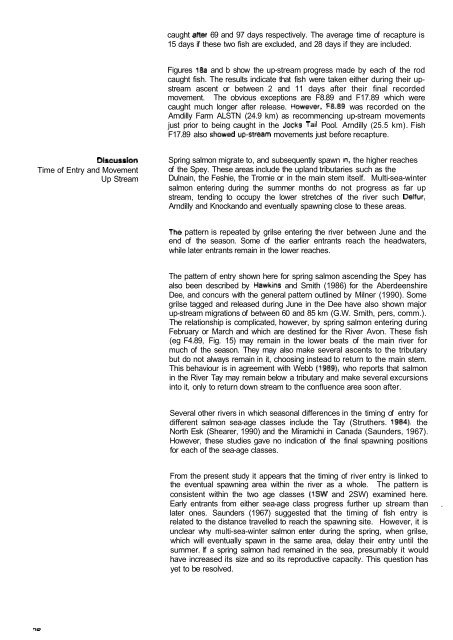( Salmo salar L.) in the River Spey as determined by
( Salmo salar L.) in the River Spey as determined by
( Salmo salar L.) in the River Spey as determined by
You also want an ePaper? Increase the reach of your titles
YUMPU automatically turns print PDFs into web optimized ePapers that Google loves.
caught atter 69 and 97 days respectively. The average time of recapture is<br />
15 days if <strong>the</strong>se two fish are excluded, and 28 days if <strong>the</strong>y are <strong>in</strong>cluded.<br />
Figures 18a and b show <strong>the</strong> up-stream progress made <strong>by</strong> each of <strong>the</strong> rod<br />
caught fish. The results <strong>in</strong>dicate that fish were taken ei<strong>the</strong>r dur<strong>in</strong>g <strong>the</strong>ir upstream<br />
<strong>as</strong>cent or between 2 and 11 days after <strong>the</strong>ir f<strong>in</strong>al recorded<br />
movement. The obvious exceptions are F8.89 and F17.89 which were<br />
caught much longer after rele<strong>as</strong>e. However, F8.89 w<strong>as</strong> recorded on <strong>the</strong><br />
Arndilly Farm ALSTN (24.9 km) <strong>as</strong> recommenc<strong>in</strong>g up-stream movements<br />
just prior to be<strong>in</strong>g caught <strong>in</strong> <strong>the</strong> Jocks Tall Pool. Arndilly (25.5 km). Fish<br />
F17.89 also shbwed up.$tmam movements just before recapture.<br />
Dlscusslon<br />
Time of Entry and Movement<br />
Up Stream<br />
Spr<strong>in</strong>g salmon migrate to, and subsequently spawn In, <strong>the</strong> higher reaches<br />
of <strong>the</strong> <strong>Spey</strong>. These are<strong>as</strong> <strong>in</strong>clude <strong>the</strong> upland tributaries such <strong>as</strong> <strong>the</strong><br />
Dulna<strong>in</strong>, <strong>the</strong> Feshie, <strong>the</strong> Tromie or <strong>in</strong> <strong>the</strong> ma<strong>in</strong> stem itself. Multi-sea-w<strong>in</strong>ter<br />
salmon enter<strong>in</strong>g dur<strong>in</strong>g <strong>the</strong> summer months do not progress <strong>as</strong> far up<br />
stream, tend<strong>in</strong>g to occupy <strong>the</strong> lower stretches of <strong>the</strong> river such Delfur,<br />
Arndilly and Knockando and eventually spawn<strong>in</strong>g close to <strong>the</strong>se are<strong>as</strong>.<br />
The pattern is repeated <strong>by</strong> grilse enter<strong>in</strong>g <strong>the</strong> river between June and <strong>the</strong><br />
end of <strong>the</strong> se<strong>as</strong>on. Some of <strong>the</strong> earlier entrants reach <strong>the</strong> headwaters,<br />
while later entrants rema<strong>in</strong> <strong>in</strong> <strong>the</strong> lower reaches.<br />
The pattern of entry shown here for spr<strong>in</strong>g salmon <strong>as</strong>cend<strong>in</strong>g <strong>the</strong> <strong>Spey</strong> h<strong>as</strong><br />
also been described <strong>by</strong> Hawk<strong>in</strong>s and Smith (1986) for <strong>the</strong> Aberdeenshire<br />
Dee, and concurs with <strong>the</strong> general pattern outl<strong>in</strong>ed <strong>by</strong> Milner (1990). Some<br />
grilse tagged and rele<strong>as</strong>ed dur<strong>in</strong>g June <strong>in</strong> <strong>the</strong> Dee have also shown major<br />
up-stream migrations of between 60 and 85 km (G.W. Smith, pers, comm.).<br />
The relationship is complicated, however, <strong>by</strong> spr<strong>in</strong>g salmon enter<strong>in</strong>g dur<strong>in</strong>g<br />
February or March and which are dest<strong>in</strong>ed for <strong>the</strong> <strong>River</strong> Avon. These fish<br />
(eg F4.89, Fig. 15) may rema<strong>in</strong> <strong>in</strong> <strong>the</strong> lower beats of <strong>the</strong> ma<strong>in</strong> river for<br />
much of <strong>the</strong> se<strong>as</strong>on. They may also make several <strong>as</strong>cents to <strong>the</strong> tributary<br />
but do not always rema<strong>in</strong> <strong>in</strong> it, choos<strong>in</strong>g <strong>in</strong>stead to return to <strong>the</strong> ma<strong>in</strong> stem.<br />
This behaviour is <strong>in</strong> agreement with Webb (1989), who reports that salmon<br />
<strong>in</strong> <strong>the</strong> <strong>River</strong> Tay may rema<strong>in</strong> below a tributary and make several excursions<br />
<strong>in</strong>to it, only to return down stream to <strong>the</strong> confluence area soon after.<br />
Several o<strong>the</strong>r rivers <strong>in</strong> which se<strong>as</strong>onal differences <strong>in</strong> <strong>the</strong> tim<strong>in</strong>g of entry for<br />
different salmon sea-age cl<strong>as</strong>ses <strong>in</strong>clude <strong>the</strong> Tay (Stru<strong>the</strong>rs. 1984), <strong>the</strong><br />
North Esk (Shearer, 1990) and <strong>the</strong> Miramichi <strong>in</strong> Canada (Saunders, 1967).<br />
However, <strong>the</strong>se studies gave no <strong>in</strong>dication of <strong>the</strong> f<strong>in</strong>al spawn<strong>in</strong>g positions<br />
for each of <strong>the</strong> sea-age cl<strong>as</strong>ses.<br />
From <strong>the</strong> present study it appears that <strong>the</strong> tim<strong>in</strong>g of river entry is l<strong>in</strong>ked to<br />
<strong>the</strong> eventual spawn<strong>in</strong>g area with<strong>in</strong> <strong>the</strong> river <strong>as</strong> a whole. The pattern is<br />
consistent with<strong>in</strong> <strong>the</strong> two age cl<strong>as</strong>ses (1SW and 2SW) exam<strong>in</strong>ed here.<br />
Early entrants from ei<strong>the</strong>r sea-age cl<strong>as</strong>s progress fur<strong>the</strong>r up stream than ,<br />
later ones. Saunders (1967) suggested that <strong>the</strong> tim<strong>in</strong>g of fish entry is<br />
related to <strong>the</strong> distance travelled to reach <strong>the</strong> spawn<strong>in</strong>g site. However, it is<br />
unclear why multi-sea-w<strong>in</strong>ter salmon enter dur<strong>in</strong>g <strong>the</strong> spr<strong>in</strong>g, when grilse,<br />
which will eventually spawn <strong>in</strong> <strong>the</strong> same area, delay <strong>the</strong>ir entry until <strong>the</strong><br />
summer. If a spr<strong>in</strong>g salmon had rema<strong>in</strong>ed <strong>in</strong> <strong>the</strong> sea, presumably it would<br />
have <strong>in</strong>cre<strong>as</strong>ed its size and so its reproductive capacity. This question h<strong>as</strong><br />
yet to be resolved.<br />
PIP
















